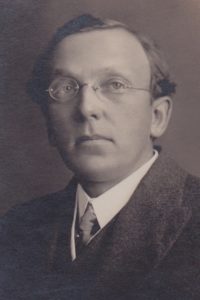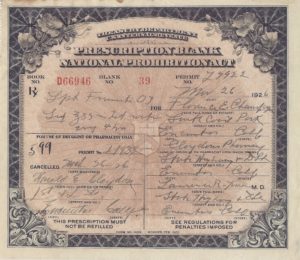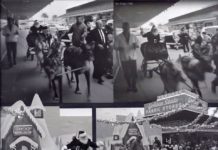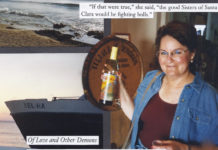
During the Roaring Twenties, Chicago had Eliot Ness and his “Untouchables.” San Diego had Charles Cass and his “Drys.”
They were not as dull as the name implies.
The National Prohibition Act, known as the Volstead Act, became the law of the land in October 1919. The purpose of this edict was to prohibit the production, transport and sale of “intoxicating liquors.” The result was bootleggers, speakeasies and bathtub gin.

Charles Lewis Cass was San Diego’s no-nonsense G-Man in charge of the federal prohibition office at 228 B Street from 1921 to 1927.
In May 1921, several prominent members of the San Diego Country Club complained to Cass about “drinking parties” on the premises. Prohibition officers nabbed illegal contraband, arrested the miscreants and polite society members were once again able to bump gums and enjoy sweet tea and lemonade at the 19th hole.
“Glad Bacchus Absent in San Diego” was the colorful headline from a February 5, 1924 article in the Bakersfield Californian. A federal prohibition officer with a sense of humor remarked, “I am glad Bacchus (the Roman god of wine and intoxication) is not here, for I hate to see a man weep.”
Under strict orders from Charles Cass, the agent poured confiscated giggle juice into a San Diego sewer. “Fifteen hundred gallons of wine, 500 gallons of whisky and other miscellaneous liquors and mash flowed freely into the drain.”
In September 1924, Cass and three Indian policemen entered the Sohoba reservation in Riverside County to arrest Bernardo Resvolosa on alcohol charges. They were quickly surrounded by 45 Mission Indian policemen and Cass argued that as a federal officer, he was only subject to federal law. The Indians disagreed and countered that whatever happened on the reservation was their business. Arrests were made, but the city marshal of Escondido refused to accept the prisoners.
A good, albeit expensive, way to obtain alcohol during prohibition was to have your doctor write a prescription. It was the modern equivalent of a prescription for medical marijuana.

In March 1926, Charles Champagne made the mistake of not properly disposing of his whiskey bottles. His wife, Florence, found an empty pint with her name on the prescription. Then she discovered more empties with other names and took them to the prohibition office. Charles Cass went after the doctor with vengeance when he learned of similar irregularities among his patients, but what the irate Mrs. Champagne did to her husband is not known.
Herbert Jaffee and Edward P. Baker owned Cerveceria Azteca (Aztec Brewery) in Mexicali, Baja California and brewed award-winning Famous A.B.C. Beer. On August 4, 1926, this highly detailed account was carried in the Santa Cruz Evening News about Mr. Jaffee’s unusual wardrobe trunk.
“In one of San Diego’s most exclusive and fashionable apartment houses, Charles Cass, federal dry officer, last night seized a portable bar, equipped with all the trappings in miniature of pre-Volstead days and more than $500 worth of the highest grades of imported liquors. The seizure was made when Cass, provided with a federal search warrant, entered the apartment occupied by Herbert Jaffe, owner of the Tijuana brewery at Mexicali, Mexico, and several saloons in Tijuana.
“The portable bar was built in a specially constructed all-steel wardrobe trunk. This, to all appearances, was an ordinary trunk, but when opened it took on a different aspect. The top of the right side of the trunk could be opened and turned back. Beneath this lay a good sized mirror, built in the finest mahogany, which could be placed on the folded back of the trunk-top. What ordinarily would have been the bottom of the tray was the top of the bar itself. This also was of high grade mahogany and at one end was an attached towel, ready – for use. The containers, extending to the bottom, supposedly for shirts and whatnot, had been converted into a keeping place of the liquor.
“And this was not all. At the bottom of the cabinet on the right side was found a rack for a detachable footrail. The footrail, a shiny nickel-plated affair, was in a cabinet on the left side. When opened and set up for “service” the trunk gave all the appearances of being a real bar. – The liquor consisted of high grade imported cordials, wine and whisky, and even beer.”
In October 1926, Cass arrested Charles Schindler, a convicted bootlegger, when 47 gallons of liquor and stills were found in two “G” Street garages under his control. A good lawyer probably could have gotten an acquittal based on the circumstantial evidence presented by the government, but the San Diego court was harsh with prohibition violations.
The highlight of Cass’s career occurred in November 1926. His officers destroyed the sophisticated smuggling ring of wealthy Tijuana distiller Hugh McClemmy. The Treasury Department described McClemmy as “the most notorious border smuggler we have to contend with.” He was “the leader of a band of airplane liquor smugglers and speed boats which carried liquor from Lower California.” McClemmy received the maximum two year sentence, but other smugglers quickly filled the vacuum.
As a side-note, the court records mysteriously disappeared, but McClemmy reported to McNeil Island on January 20, 1928 to serve his prison term. Although not as notorious as the metal squirting minions of Al Capone, McClemmy associates and competitors were also known to “disappear.”
July 1927 was a busy month for Cass and his Dry Boys.
They raided Grover Click’s gas station at Park and University and confiscated 13 pints of whisky, two gallons of wine and 22 quarts of gin. Three pints of liquor were found in a teapot at the residence of Charles Smith. Peggy Robbins was arrested when she was caught pouring liquor into her sink. Her husband was already in custody “on liquor charges.” Finally, Chief Mastersen was busted with two gallons of liquor in his home.
Then came a September 1927 “shake-up” within the Southern California prohibition agencies that was necessitated “to tighten enforcement against the influx of holiday liquor.” Cryptically, Charles Cass was transferred to Fresno. Although corruption was rampant among prohibition officers and highbinders, there was never a hint of wrongdoing by Cass. He may have done his job too well and stepped on the wrong toes.
The embittered Cass quickly reported his replacement, Colonel Lee Stromee, for accepting bribes from smugglers. Stromee, was later indicted in December 1927 for conspiracy along with Frank Cornero, brother of “Tony the Bootlegger King” Cornero, to unload 27,000 cases of liquor from speedboats near San Diego. Charges were apparently dropped in 1929 when the witness was “too ill” to testify against Stromee.
Reporting corruption was a political mistake for Charles Cass. In retirement, he wrote about malfeasance and incompetency within the federal prohibition agency. He complained that the leadership was predominantly former Army officers who were untrained in law enforcement, but well-trained in the consumption of alcoholic beverages.
Cass loved to write in the grandiloquent style of the day and left an esoteric essay about conflict titled “Today and Tomorrow.” The aged crusader addressed the conflict created by the Volstead Act and theorized, “…the fact of its existence in the present conflict is no argument for demanding that the conflict cease, for that bitterness is but an atom compared to the enormous volume of misery, want and woe produced by the liquor traffic.”
Just as admirals retire in Coronado to tend roses, the austere Cass eventually returned to San Diego and retired in Bay Park where he cultivated succulents and staghorn ferns that still bare his name.
But this was not until he had done his best to weed out San Diego’s rumrunners, smugglers and gangsters during the Roaring Twenties.
Agent Cass died in 1952 at age 77. It is not known if he ever cracked a smile in his life.
Email: Bill@ClairemontTimes.com



